SIGGRAPH 2014: Acting in Translation
Chair(s):
- Başak Şenova
-
- Koç University
Art Papers Chair(s):
- Teri Rueb
-
- State University of New York, Buffalo
Location:
San Francisco, California, United States of America
Dates:
August 10th-14th, 2014
Art Show Overview:
Introduction
In the sea of ever-changing conditions of multiple realities, there is no single or homogenous approach, but a diversity of resisting mechanisms and artistic strategies. Therefore, translation, as a term and as a tool, generates plenty of potential fields for art production in disconnected trajectories. Furthermore, these fields have the capability to cover and merge with other fields of knowledge. Translation indicates a detached and forward movement from the source. It is also a freeing act, which paradoxically contains a burden of responsibility for the source. Therefore, this movement has limits and fine borderlines, yet it could designate “more” than the source. Translation is a call for other realities and also another way to see other realities. Translation can also blend “fact” with fiction by blurring the difference between them. In this vein, translation as a term could be interpreted in multiple ways on different layers of perception. While this term indicates a mechanical act, it may also refer to global and local societal developments such as resistance movements, alternative economies, information leaks, migration flows, and mobility.
Works in the Art Gallery have several common approaches and angles. While some of them position the viewer as the witness of what the work is, criticizes, and/or processes, others encourage the viewer to be part of their content through interactive approaches. Some works inhabit experiences with different media and formats, while some produce inquiries about technological developments and their political, ideological, cultural, and economic implications.
Points of View (2013–2014) by Zohar Kfir is an ongoing interactive database-driven web documentary that represents a collaboration between the artist and B’Tselem’s Camera Distribution Project (The Israeli Information Center for Human Rights in the Occupied Territories, www.btselem.org). The work enables viewers to navigate through a variety of scenes, locations and timelines in the West Bank and Gaza from multiple points of view. Points of View is a perfect example of translating traditional cinematic techniques with interactivity, layering visuals, compressing and expanding time, and fracturing narrative. The project both conveys the day-to-day lives of Palestinians and documents some of the human rights violations that occur in the region. Subway Stories (2013) by Alon Chitayat is another work about personal stories and how they are merged with daydreaming and imagination. The work also inhabits a strong criticism of control mechanisms and isolation, experienced on a daily basis: the “conductor’s box” enables the viewer/user to control the projection and its focus point.
While one handle is controlling the train’s speed, the other handle sets the camera zoom. The thoughts and sounds of the passenger in focus are heard according to the movements and decisions of the viewer/user. Paul Stout’s Apparition (2014) is an installation composed of many contrasting materials including glass, plastic, electronic components, wire, brass, steel, LCD screens, and preserved plant and animal matter. The work eliminates the interaction factor by positioning the viewer as “the witness” of its continuous course. Apparition’s content is articulated by observing and exposing a set of natural processes envisioned as elaborate machines. Ecological catastrophes are also the subject of Rachele Riley’s The Evolution of Silence (2013). The work is a web-based archive, visualizing the scale of damage brought about by nuclear testing at the Nevada Test Site. By navigating through this archive based on a non-linear map, the viewer experiences this restricted desert landscape as a personal voyage.
Acting in Translation Gallery Chair
Başak Şenova
Art Show Jury:
- Mona Kasra
-
- University of Virginia
- Amit Zoran
-
- The Hebrew University of Jerusalem
- Kate Armstrong
-
- Emily Carr University of Art + Design
- Cézanne Charles
-
- ArtServe Michigan
- Mushon Zer-Aviv
-
- Shenkar College of Engineering and Design
Art Show Reviewers:
- Bonnie L Mitchell
-
- Bowling Green State University
Exhibition Artworks:
-

Apparition
[Paul L. Stout]
Categories: [3D & Sculpture] -
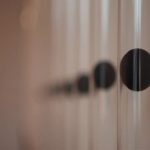
Levitate
[Hyunwoo Bang] [Yunsil Heo]
Categories: [3D & Sculpture] -
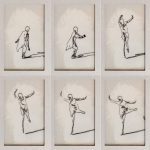
Lineographs
[Joseph Farbrook]
Categories: [2D & Wall-Hung] -
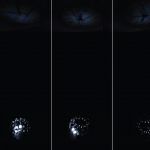
Looking Glass Time
[Yoichi Ochiai]
Categories: [Animation & Video] -
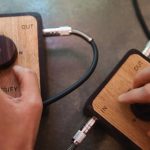
Modern Video Processor
[Hyunwoo Bang] [Yunsil Heo]
Categories: [Electronic/Robotic Object] [Interactive & Monitor-Based] -
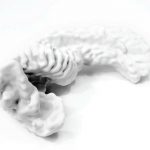
Mother
[Inmi Lee] [Kyle McDonald]
Categories: [3D & Sculpture] -

Points of View
[Zohar Kfir]
Categories: [Interactive & Monitor-Based] -
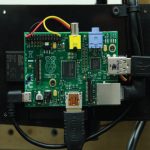
SeeMore
[Sam Blanchard] [Kirk Cameron]
Categories: [3D & Sculpture] -
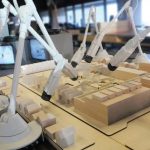
Speculatorum Oculi
[Erik Brunvand]
Categories: [Installation] -
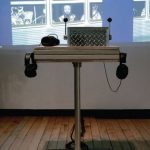
Subway Stories
[Alon Chitayat] [Jeff Ong]
Categories: [Installation] -

Transiconmorphosis
[Fito Segrera] [Emilio Vavarella]
Categories: [Interactive & Monitor-Based]
Exhibition Writings and Presentations:
-
Title:
A Piece of the Pie Chart: Feminist Robotics
Author(s):
Category: Paper
Abstract Summary:
This paper analyzes the robotic gallery installation A Piece of the Pie Chart. The project addresses gender inequity in the tech world. It consists of a computer workstation and a food robot. The food robot puts pie charts onto edible, pre-baked pies. They depict the gender gap in technical environments. Visitors use the robot to create pies. Pictures of the pies are disseminated via Twitter, and the physical pies are mailed to the places where the data originated. In the following text, the author disassembles the machine in the context of feminist theory, feminist technology research, visualization, and political robotics.
Title: Aesthetics of Biocybernetic Designs: A Systems Approach to Biorobots and Its Implications for the Environment
Author(s):
Category: Paper
Abstract Summary:
The authors identify some of the theoretical premises of biocybernetic art objects, with reference to the works of Nam June Paik, Edward Ihnawitz, Ulrike Gabriel, and most notably, Gilberto Esparza, the Mexican biocybernetic artist. Systems theory anticipates stochastic convergences in nature, defying the classic certitude of the teleological notion of form. Evidence for this paradigmatic shift is found in the biocybernetic creatures conceived by these roboticists. In much biocybernetic art, beauty emerges in the form of adaptive mechanisms, such as in robotic tetrapods or self-organizing artificial plants. Such structures provide a template for survival mechanisms in an increasingly entropic environment.
Title: Creature:Interactions: A Social Mixed-Reality Playspace
Author(s):
Category: Paper
Abstract Summary:
This paper discusses Creature:Interactions (2015), a large-scale mixed-reality artwork created by the authors that incorporates immersive 360° stereoscopic visuals, interactive technology, and live actor facilitation. The work uses physical simulations to promote an expressive full-bodied interaction as children explore the landscapes and creatures of Ethel C. Pedley’s ecologically focused children’s novel, Dot and the Kangaroo. The immersive visuals provide a social playspace for up to 90 people and have produced “phantom” sensations of temperature and touch in certain participants.
Title: Malleable Environments and the Pursuit of Spatial Justice in the Bronx
Author(s):
Category: Paper
Abstract Summary:
A design team in the Hunts Point neighborhood of the South Bronx used methodologies of performance and collaborative, location-based storytelling to contend with the effects of urban spatial injustice in the community. Ideation via a series of participatory performances led to creation of a mobile cinema application as the starting point for public, location-based cinema walks. The application accepts usergenerated content, acting as a new form of generative monument to the neighborhood as it evolves. The project exemplifies how installing situated technologies for an embodied form of participation can help translate local concerns to outside audiences, in this case using a metaphorical, locative media platform to discuss the evolving nature of environmental discrimination, over-incarceration, and urban spatial justice in New York City.
Title: Nervous Ether: Soft Aggregates, Interactive Skins
Author(s):
Category: Paper
Abstract Summary:
This paper describes the authors’ exploration and experimentation with cellular pneumatic aggregates for kinetic, environmentally responsive envelope systems. The work is situated within the history and technology of pneumatic structures, biological paradigms, the agency and aesthetics of material, information translation, and the tension between performance and affect within responsive environments. The paper elaborates on the physical and computational development of novel pneumatic systems, experimentation with their interactive capabilities, and a recently completed installation, Nervous Ether, a pneumatic spatial envelope that operates as an instrument to register and communicate remote environmental information while also developing affective interaction with inhabitants.
Title: Object Intermediaries: How New Media Artists Translate the Language of Things
Author(s):
Category: Paper
Abstract Summary:
This paper uses Walter Benjamin’s concept of translation between people and things as a focal point for analysis of the work of contemporary new-media artists Paula Gaetano Adi and Lindsey French, who utilize robotics and interactive technology to explore interspecies communication. Framed by materialist, poststructuralist, and posthumanist theory, along with recent discourse in object-oriented ontology, this paper poses the work of Gaetano Adi and French as potential models for visualizing object-oriented and vital materialist interactions. In the age of the Anthropocene, thinking beyond the human has become increasingly vital in both ethical and ecological terms, making the ability to envision less anthropocentric, more object-oriented worldviews both novel and timely.
Title: Posture Platform and The Drawing Room: Virtual Teleportation in Cyberspace
Author(s):
Category: Paper
Abstract Summary:
Three-hundred-sixty-degree audio/visual immersion and the restoration of non-verbal communication cues are essential features for interfaces inviting the human body in cyberspace. The Posture Platform is a network of bases that offers access to a shared virtual environment. Each base is composed of an immersive 360-degree visual display, a surround-sound system, an array of image capture devices, a microphone, an omnidirectional controller/pointer, and a computer with wifi and an internet connection. The Drawing Room is the most recent virtual space developed for the platform. It invites participants to a blank shared space where they draw their own environment collaboratively. The platform, and the project it hosts, is an example of the art, design, and engineering challenges and opportunities associated with development of inhabitable cyberspace.
Title: The Aesthetics of Liminality: Augmentation as Artform
Author(s):
Category: Paper
Abstract Summary:
From ARToolkit’s emergence in the 1990s to the emergence of augmented reality (AR) as an art medium in the 2010s, AR has developed as a number of evidential sites. As an extension of virtual media, it merges real-time pattern recognition with goggles (finally realizing William Gibson’s sci-fi fantasy) or handheld devices. This creates a welding of real-time media and virtual reality, or an optically registered simulation overlaid upon an actual spatial environment. Commercial applications are numerous, including entertainment, sales, and navigation. Even though ARbased works can be traced back to the late 1990s, AR work requires some understanding of coding and tethered imaging equipment. It was not until marker-based AR, affording lower entries to usage, as well as geo-locational AR-based media, using handheld devices and tablets, that augmented reality as an art medium would propagate. While one can argue that AR-based art is a convergence of handheld device art and virtual reality, there are intrinsic gestures specific to augmented reality that make it unique. The author looks at some historical examples of AR as well as critical issues of AR-based gestures such as compounding the gaze, problematizing the retinal, and the representational issues of informatic overlays. This generates four gestural vectors, analogous to those defined in “The Translation of Art in Virtual Worlds,” which is examined through case studies. From this, a visual theory of augmentation will be proposed.
Title: Transmission: A Telepresence Interface for Neural and Kinetic Interaction
Author(s):
Category: Paper
Abstract Summary:
Transmission is both a telepresence performance and a research project. As a real-time visualization tool, Transmission creates alternate representations of neural activity through sound and vision, investigating the effect of interaction on human consciousness. As a sonification project, it creates an immersive experience for two users: a soundscape created by the human mind and the influence of kinetic interaction. An electroencephalographic (EEG) headset interprets a user’s neural activity. An Open Sound Control (OSC) script then translates this data into a real-time particle stream and sound environment at one end. A second user in a remote location modifies this stream in real time through body movement. Together they become a telematic musical interface—communicating through visual and sonic representation of their interactions.
Title: XEPA - Autonomous Intelligent Light and Sound Sculptures That Improvise Group Performances
Author(s):
Category: Paper
Abstract Summary:
XEPA anticipates a future where machines form their own societies. Going beyond mere generative art, machines will exhibit artistic creativity with the addition of artistic judgment via computational aesthetic evaluation. In such a future our notions of aesthetics will undergo a radical translation. The XEPA intelligent sculptures create animated light and sound sequences. Each sculpture “watches” the others and modifies its own aesthetic behavior to create a collaborative, improvisational performance. No coordination information or commands are used. Each XEPA independently evaluates the aesthetics of the other sculptures, infers a theme or mood being attempted, and then modifies its own aesthetics to better reinforce that theme. Each performance is unique and widely varied. XEPA is an ever-evolving artwork, intended as a platform for ongoing experiments in computational aesthetic evaluation.




